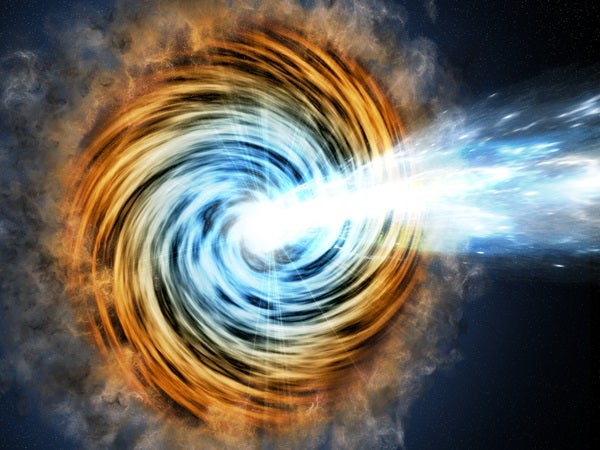“With VERITAS, we detected gamma rays from this unusual object at the highest energies observed on Earth,” said Jonathan Biteau, who led the analysis of the data as a postdoctoral researcher at UC Santa Cruz.
Such very high-energy gamma rays were unexpected, he said, because they faced a good chance of being annihilated at some point during the 7.6 billion years they spent traveling toward Earth. When high-energy gamma rays collide with lower-energy photons, they annihilate and create an electron-positron pair. To reach telescopes on Earth, the gamma rays from PKS 1441+25 had to avoid a tight net of photons surrounding the vicinity of the black hole, as well as a looser net of photons, the extragalactic background light (EBL), that fills the universe.
The EBL is a faint glow that pervades the space between galaxies, consisting of photons from all the stars and galaxies that have existed. It is hard to measure because there are so many bright sources of light nearby. Astronomers have used cosmological models to estimate the EBL, galaxy counts to set lower limits, and gamma rays from blazars (as well as direct observations of dark patches of sky) to set upper limits. The farther gamma rays have to travel the more likely they are to encounter photons of the EBL and annihilate, so the detection of a source 7.6 billion light-years away was surprising.
“With PKS 1441+25, we can now place tight constraints on this loose net of photons,” said Biteau. “This is clearly the opening of a new era where we can compare source-by-source measurements and start to probe the cosmic evolution of the extragalactic background light.”
Biteau, now an associate professor at Institut de Physique Nucléaire d’Orsay in France, and UC Santa Cruz graduate student Caitlin Johnson are corresponding authors of a paper on the findings to be published in Astrophysical Journal Letters and currently available online. Johnson analyzed data from the Fermi Gamma-ray Space Telescope which complemented the data from VERITAS.
“Combining the Fermi data with the VERITAS data enabled us to make the constraints on the EBL much tighter,” she said. “The window is slowly narrowing.”
But what about the tight net of photons around the tremendously bright blazar? That helps locate the region where the gamma rays were emitted, said coauthor David Williams, adjunct professor of physics at UC Santa Cruz. “If the gamma rays were produced close to the black hole, the radiation fields there are strong enough to absorb them. So the fact that the gamma rays are getting out of the galaxy at all indicates they were produced farther away from the black hole,” Williams said.
The black hole is surrounded by a glowing disk of hot gas and dust swirling in toward the center. Some of this infalling matter, instead of being swallowed by the black hole, gets channeled into two powerful jets emitted from the poles of the spinning black hole, perpendicular to the accretion disk. One of these jets is pointing in our direction, “like a flashlight shining in our eyes,” Johnson said.
Physicists are still debating the exact mechanism behind gamma-ray emissions from the jets, but PKS 1441+25 provides important clues, Biteau said. “With observations across the entire electromagnetic spectrum, we have now realized that the location of the gamma-ray emissions for this source has to be at least a tenth of a light-year away from the black hole. Otherwise, none of the gamma rays would escape,” he said.
The researchers estimated that the emission region is probably at a distance of about five light-years from the black hole, much further than expected. According to a leading scenario for the gamma-ray emissions, high energy electrons are accelerated to near the speed of light in the jet, interact with photons, and transfer their energy, boosting the photons to gamma-ray energies.
“These observations constitute a fantastic step forward in our understanding of blazars as cosmic accelerators and as light beacons for gamma ray cosmology,” Biteau said.










